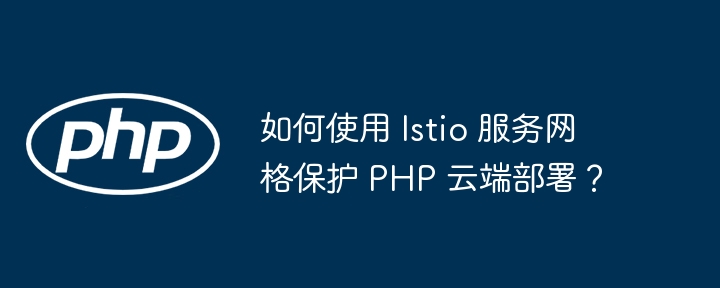Home >Backend Development >PHP Tutorial >How to secure PHP cloud deployment using Istio service mesh?
How to secure PHP cloud deployment using Istio service mesh?
- WBOYWBOYWBOYWBOYWBOYWBOYWBOYWBOYWBOYWBOYWBOYWBOYWBOriginal
- 2024-05-06 17:12:011211browse
By using the Istio service mesh, you can provide the following protection features for PHP cloud deployments: Security: Protect applications from threats by proxying traffic and enforcing authorization. Resilience: Increase application availability through load balancing, failover, and automatic retries. Observability: Provide deep insights into application health through logging, metrics, and distributed tracing.

How to use Istio service mesh to protect PHP cloud deployment
Introduction
Istio is an open source service mesh that provides security, resiliency, and observability for cloud-native applications. This tutorial will guide you through how to secure your PHP cloud deployment on Kubernetes using Istio.
Setup
-
Installing Istio
Install Istio using the instructions in the official Istio documentation. -
Create a Kubernetes cluster
Create or use an existing Kubernetes cluster.
Create a PHP application
-
Create a Docker image
Create a Docker image containing a PHP application. -
Push the image to the registry
Push the image to the Docker image registry.
Deploy applications to Kubernetes
-
Create a deployment manifest
Create a Kubernetes deployment manifest (deployment), where Specify the image, port and other information of the PHP application. -
Deploy the application
Use thekubectlcommand to apply the deployment manifest to the Kubernetes cluster.
Inject Istio Sidecar into Pods
Inject Istio sidecar container for each Pod, which will proxy between application traffic and the outside world . To do this:
-
Enable Istio injection
Use theistioctltool provided by Istio to enable Istio injection:istioctl manifest apply --set profile=default -f istio.yaml
-
Redeploy the application
Redeploy the application to enable Istio sidecar injection.
Practical case: flow control
Istio can provide various flow control functions. The following practical case shows how to use Istio to limit concurrent requests to PHP applications:
-
Create VirtualService
Create a VirtualService object to define flow control rules:apiVersion: networking.istio.io/v1alpha3 kind: VirtualService metadata: name: php-app-vs spec: gateways: - php-app-gateway hosts: - php-app.default.svc.cluster.local http: - route: - destination: host: php-app port: number: 80 - weight: 100 match: - requestType: SIMPLE request_timeout: 50ms retries: attempts: 3 perTryInterval: 500ms virtualCluster: mesh: cluster-local -
Apply VirtualService
UsekubectlApply VirtualService:kubectl apply -f php-app-vs.yaml
Conclusion
By integrating Istio into your PHP cloud deployment, you gain powerful security, resiliency, and observability features. This tutorial explains how to set up Istio and illustrates its capabilities using practical examples such as flow control.
The above is the detailed content of How to secure PHP cloud deployment using Istio service mesh?. For more information, please follow other related articles on the PHP Chinese website!

